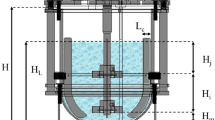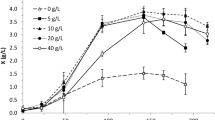Summary
Influence of pressure (P) and oxygen partial pressure (\(P_{O_2 }\)) on cultivation of various Streptomyces spp. and Micromonospora purpurea was examined in pressurized air-lift and stirred tank fermenters. The maximum \(P_{O_2 }\) was 2100 mbar. Growth and product formation of all cultures tested were markedly influenced by \(P_{O_2 }\) higher than 1000 mbar. There is evidence that wild strains are more oxygen tolerant than production strains. At a certain \(P_{O_2 }\) the metabolic activities of all cultures were inhibited. However, results obtained with S. aureofaciens and S. rimosus indicated an increase in specific product formation rate at elevated pressure. With increase in oxygen tension incorporation of oxygen into tetracycline molecules was enhanced. Since elevated oxygen tension can either show inhibiting effects or may be used for regulation of product formation and selectivity, the influence of \(P_{O_2 }\) should be determined in an appropriate experimental set-up for each process.
Similar content being viewed by others
References
Béhal V (1987) The tetracycline fermentation and its regulation. CRC Crit Rev Biotechnol 5:275–318
Bylinkina ES, Birukov VV (1972) The problem of scale-up in antibiotic biosynthesis. In: Terui G (ed) Proceedings of the 4th International Fermentation Symposium: Fermentation Technology Today. Yamada-Kami, Suita-Shi, Osaka, Japan, pp 105–115
Clark DS, Lentz CP (1961) Submerged citric acid fermentation of sugar beet molasses: effect of pressure and recirculation of oxygen. Can J Microbial 7:447–453
Harrison DEF (1972) Physiological effects of dissolved oxygen tension and redox potential on growing populations of microorganisms. J Appl Chem Biotechnol 22:417–440
Jostmann Th (1986) Einfluss des Gesamtdrucks und des Sauerstoffpartialdrucks auf das Wachstum des Bakteriums Pseudomonas fluorescens im Druck-Schlaufenreaktor. Doctoral Thesis, University of Dortmund
Khan AH, Ghose TK (1973) Kinetics of citric acid fermentation by Aspergillus niger. J Ferment Technol 51:734–741
Liefke E (1988) Kultivierung aerober Bakterien bei erhöhtem Sauerstoffpartialdruck als verfahrenstechnische Möglichkeit zur Beeinflussung von Wachstum und Produktbildung. Doctoral Thesis, University of Dortmund
Mukhopadhyay SN, Ghose TK (1976) Oxygen participation in fermentation. Part 1. Oxygen microorganism interactions. Process Biochem 11:19–21
Oka H, Uno K, Harada KI, Yasaka K, Suzuki M (1984) A simple method for the analysis of tetracyclines using reversed-phase high performance liquid chromatography. J Chromatogr 298:435–443
Okoshi H, Sato S, Mukataka S, Takahashi J (1987) Citric acid production by Candida tropicalis under high dissolved oxygen concentrations. Agric Biol Chem 51:257–258
Onken U (1990) Batch and continuous cultivation of Pseudomonas fluorescens at increased pressure. Biotechnol Bioeng in press
Onken U, Liefke E (1989) Effect of total and partial pressure (oxygen and carbon dioxide) on aerobic microbial processes. Adv Biochem Eng Biotechnol 40:137–169
Onken U, Jostmann Th, Weiland P (1984) Effect of hydrostatic pressure on microbial growth for fermentation process modelling. In: Proceedings of the 3th European Congress of Biotechnology vol 3. VCH, Weinheim, pp 481–488
Onken U, Kiese S, Jostmann Th (1984) An airlift fermenter for continuous cultures at elevated pressures. Biotechnol Lett 6:283–288
Oosterhuis NMG, Groesbeek NM, Kossen NWF, Schenk ES (1985) Influence of dissolved oxygen concentration on the oxygen kinetics of Gluconobacter oxydans. Appl Microbiol Biotechnol 21:42–49
Puhar E, Lorencez I, Fiechter A (1983) Influence of partial pressure of oxygen and carbon dioxide on Methylomonas clara in continuous culture. Eur J Appl Microbiol Biotechnol 18:131–134
Ryu DY, Humphrey AE (1972) A reassessment of oxygen transfer rates in antibiotics fermentations. J Ferment Technol 50:424–431
Sweere APJ, Luyben KChAM, Kossen NWF (1987) Regime analysis and scale-down: tools to investigate the performance of bioreactors. Enzyme Microb Technol 9:386–398
Träger M, Müller U, Onken U (1987) Einfluss erhöhter Sauerstoffpartialdrücke auf die Bildung von Gluconsäure durch Gluconobacter oxydans. Chem Ing Tech 59:939–940
Vardar F (1983) Problems of mass and momentum transfer in large fermenters. Process Biochem 18:21–23
Vardar F, Lilly MD (1982) Effect of cycling dissolved oxygen concentrations on product formation in penicillin productions. Eur J Appl Microbiol Biotechnol 14:203–211
Vorísek J, Powell AJ, Vanek Z (1969) Regulation of biosynthesis of secondary metabolites. Folia Microbiol 14:398–405
Author information
Authors and Affiliations
Additional information
Offprint requests to: U. Onken
Rights and permissions
About this article
Cite this article
Liefke, E., Kaiser, D. & Onken, U. Growth and product formation of actinomycetes cultivated at increased total pressure and oxygen partial pressure. Appl Microbiol Biotechnol 32, 674–679 (1990). https://doi.org/10.1007/BF00164738
Received:
Accepted:
Issue Date:
DOI: https://doi.org/10.1007/BF00164738




